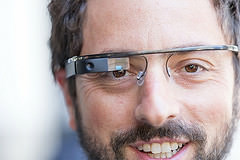Through the Google Glass
Exploring Google Glass from a filmmaker’s POV and its potential to change filmmaking
By Muneer Huda, Staff Writer
 We’ve seen Google Glass’s video captures capabilities through the eyes of the adrenaline junkie. Spanish doctor Pedro Guillen made the news when he wore Glass to stream a live surgery to MDs around the world. And now Glass is venturing into the world of filmmaking.
We’ve seen Google Glass’s video captures capabilities through the eyes of the adrenaline junkie. Spanish doctor Pedro Guillen made the news when he wore Glass to stream a live surgery to MDs around the world. And now Glass is venturing into the world of filmmaking.
Imagine: a 720p HD head mounted camera with a built in mic and near limitless recording capacity via cloud storage.
Yawn. DSLR cameras and cell phones are already being used to make high quality videos, slowly sneaking into the world of ‘professional’ production. Parts of the Oscar nominated movie 127 Hours was shot exclusively using a DSLR camera and there are film festivals dedicated to movies made using only smartphones. Using a headwear mounted camera just seems like a natural progression of the tech trend.
Google Glass announced that five film schools would be given the opportunity to explore their creativity using Glass: the American Film Institute, California Institute of the Arts, Rhode Island School of Design, UCLA School of Theater, Film, and Television, and the University of Southern California. There’s a lot of excitement among film students and by those many overlooked for this opportunity. But what real potential does Glass have to change filmmaking?
The filmmaker’s (camera) angle
“It’s simply another tool for amateur, or soon-to-be professional filmmakers,” says Ahmed Khawaja, a 2010 Film and TV Productions graduate from Boston University. “If anything, Glass feels more robotic, and less human, because it’s so fixed to the plane of view at eye-level.”
[pullquote]“If anything, Glass feels more robotic, and less human, because it’s so fixed to the plane of view at eye-level.”[/pullquote]
Ahmed is a diary-documentary filmmaker and though he has doubts of Glass’s revolutionary contribution to filmmaking, he sees its advantage.
“Glass will allow me to see people as I experience them, and our interactions won’t have to be dictated by the setting up of a camera, which might not capture all the “good” moments that feel real and unforeseen. Glass might serve the purposes of a hidden camera scenario, where raw, spontaneous moments are desired by a filmmaker.”
Ahmed is referring to documentary style or unscripted filmmaking, like in The Blair Witch Project. But what about more ‘traditional’ forms of filmmaking?
“I see Glass working superbly for shots that emulate the human point of view, like in slasher movies, where the POV can be used for first-person emphasis, and thus maximum viewer immersion.” The 2012 movie Maniac, a remake of the 1980 slasher flick, uses a lot of these camera shots for storytelling. The audience experiences the action from the protagonist’s perspective as he stalks his victims, a mark of the psychological slasher movie genre. As in Maniac, Glass can be used to capture other first person action perspectives to give audiences an augmented reality experience.
The revolution
Glass isn’t the next big break in filmmaking. That’s okay, Google isn’t fooling itself or anyone else with that kind of marketing. But here’s a simple truth: Glass is cool. A frame mounted video recorder where you can share a live feed with friends on the other side of the world? Hard not to be taken in by that.
With many popular Internet venues like Youtube and Vimeo for amateur filmmakers to showcase their art, Glass will only speed the birth of your basement Tarantinos and Scorseses. And while Glass itself as a recording device may not be revolutionary, it is very possible that future apps developed for it may do something unique for filmmaking.
The academy award winning documentary ‘Searching for Sugar Man’ was shot using Super 8 film to capture the more nostalgic feel of the 1970s. However, near the end of filming the production ran out of Super 8 film and could not afford any more. The director Malik Bendjelloul looked to the 8mm Vintage Camera app for the iPhone in desperation. The results were near indistinguishable from parts of the movie made using the costly Super 8 film.
The app cost $1.99.
What if Bendjelloul had shot most of his movie on a smartphone? How much money could he have saved in production? What other kind of apps are possible to help the visionary filmmaker? It is here where the revolutionary potential of Glass sleeps.
Muneer Huda writes out of Waterloo, Ontario. He enjoys all kinds of writing, but has a special love for speculative fiction. He aspires to support himself solely through his writing one day. http://muneerhuda.wordpress.com/































Share the post "Through the Google Glass"